Serpentinite

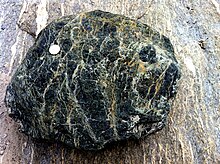

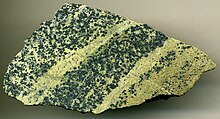

Serpentinite is a rock composed of one or more serpentine group minerals, the name originating from the similarity of the texture of the rock to that of the skin of a snake.[1] Minerals in this group, which are rich in magnesium and water, light to dark green, greasy looking and slippery feeling, are formed by serpentinization, a hydration and metamorphic transformation of ultramafic rock from the Earth's mantle. The mineral alteration is particularly important at the sea floor at tectonic plate boundaries.[2]
Formation and petrology[]
Serpentinization is a form of low-temperature metamorphism of ultramafic rocks, such as dunite, harzburgite, or lherzolite. These are rocks low in silica and composed mostly of olivine, pyroxene, and chromite. Serpentinization is driven largely by hydration and oxidation of olivine and pyroxene to serpentine minerals, brucite, and magnetite.[3] Under the unusual chemical conditions accompanying serpentinization, water is the oxidizing agent, and is itself reduced to hydrogen, H
2. This leads to further reactions that produce rare iron group native element minerals, such as awaruite (Ni
3Fe) and native iron;[4] methane and other hydrocarbon compounds; and hydrogen sulfide.[5]
During serpentinization, large amounts of water are absorbed into the rock, increasing the volume, reducing the density and destroying the original structure.[6][7] The density changes from 3.3 to 2.5 g/cm3 (0.119 to 0.090 lb/cu in) with a concurrent volume increase on the order of 30-40%.[8] The reaction is highly exothermic and rock temperatures can be raised by about 260 °C (500 °F),[7] providing an energy source for formation of non-volcanic hydrothermal vents.[9] The hydrogen, methane, and hydrogen sulfide produced during serpentinization are released at these vents and provide energy sources for deep sea chemotroph microorganisms.[10][7]
The final mineral composition of serpentinite is usually dominated by lizardite, chrysotile, and magnetite. Brucite and antigorite are less commonly present. Lizardite, chrysotile, and antigorite are serpentine minerals. Accessory minerals, present in small quantities, include awaruite, other native metal minerals, and sulfide minerals.[3]
Formation of serpentine minerals[]
Olivine is a solid solution of forsterite, the magnesium-endmember, and fayalite, the iron-endmember, with forsterite typically making up about 90% of the olivine in ultramafic rocks.[11] Serpentinite can form from olivine via several reactions:
-
+ + 4 H
2O →(Reaction 1a)
-
+ → +
(Reaction 1b)
Reaction 1a tightly binds silica, lowering its chemical activity to the lowest values seen in common rocks of the Earth's crust.[12] Serpentinization then continues through the hydration of olivine to yield serpentine and brucite (Reaction 1b).[13] The mixture of brucite and serpentine formed by Reaction 1b has the lowest silica activity in the serpentinite, so that the brucite phase is very important in understanding serpentinization.[12] However, the brucite is often blended in with the serpentine such that it is difficult to identify except with X-ray diffraction, and it is easily altered under surface weathering conditions.[14]
A similar suite of reactions involves pyroxene-group minerals:
-
+ + H
2O →(Reaction 2a)
-
+ 3 H
2O → +(Reaction 2b)
Reaction 2a quickly comes to a halt as silica becomes unavailable, and Reaction 2b takes over.[15] When olivine is abundant, silica activity drops low enough that talc begins to react with olivine:
-
+ + →
(Reaction 3)
This reaction requires higher temperatures than those at which brucite forms.[14]
The final mineralogy depends both on rock and fluid compositions, temperature, and pressure. Antigorite forms in reactions at temperatures that can exceed 600 °C (1,112 °F) during metamorphism, and it is the serpentine group mineral stable at the highest temperatures. Lizardite and chrysotile can form at low temperatures very near the Earth's surface.[16]
Breakdown of diopside and formation of rodingites[]
Ultramafic rocks often contain calcium-rich pyroxene (diopside), which breaks down according to the reaction
-
+ 6 H+
→ + 3 Ca2+
+ H
2O +(Reaction 4)
This raises both the pH, often to very high values, and the calcium content of the fluids involved in serpentinization. These fluids are highly reactive and may transport calcium and other elements into surrounding mafic rocks. Fluid reaction with these rocks may create metasomatic reaction zones enriched in calcium and depleted in silica, called rodingites.[17]
Formation of magnetite and hydrogen[]
In most crustal rock, the chemical activity of oxygen is prevented from dropping to very low values by the fayalite-magnetite-quartz (FMQ) buffer.[4] The very low chemical activity of silica during serpentinization eliminates this buffer, allowing serpentinization to produce highly reducing conditions.[12] Under these conditions, water is capable of oxidizing ferrous (Fe2+
) ions in fayalite. The process is of interest because it generates hydrogen gas:[18][19]
-
+ → + +
(Reaction 5)
However, studies of serpentinites suggest that iron minerals are first converted to ferroan brucite, Fe(OH)
2,[20] which then undergoes the Schikorr reaction in the anaerobic conditions of serpentinization:[21][22]
-
→ + +
(Reaction 6)
Maximum reducing conditions, and the maximum rate of production of hydrogen, occur when the temperature of serpentinization is between 200 and 315 °C (392 and 599 °F).[23] If the original ultramafic rock (the protolith) is peridotite, which is rich in olivine, considerable magnetite and hydrogen are produced. When the protolith is pyroxenite, which contains more pyroxene than olivine, iron-rich talc is produced with no magnetite and only modest hydrogen production. Infiltration of silica-bearing fluids during serpentinization can suppress both the formation of brucite and the subsequent production of hydrogen.[24]
Chromite present in the protolith will be altered to chromium-rich magnetite at lower serpentinization temperatures. At higher temperatures, it will be altered to iron-rich chromite (ferrit-chromite).[25] During serpentinization, the rock is enriched in chlorine, boron, fluorine, and sulfur. Sulfur will be reduce to hydrogen sulfide and sulfide minerals, though significant quantities are incorporated into serpentine minerals, and some may later be reoxidized to sulfate minerals such as anhydrite.[8] The sulfides produced include nickel-rich sulfides, such as mackinawite.[26]
Methane and other hydrocarbons[]
Laboratory experiments have confirmed that at a temperature of 300 °C (572 °F) and pressure of 500 bars, olivine serpentinizes with release of hydrogen gas. In addition, methane and complex hydrocarbons are formed through reduction of carbon dioxide. The process may be catalyzed by magnetite formed during serpentinization.[5] One reaction pathway is:[21]
-
+ + 26 H
2O + CO
2 → + +(Reaction 7)
Metamorphism at higher pressure and temperature[]
Lizardite and chrysotile are stable at low temperatures and pressures, while antigorite is stable at higher temperatures and pressure. Its presence in a serpentinite indicates either that serpentinization took place at unusually high pressure and temperature or that the rock experienced higher grade metamorphism after serpentinization was complete.[16]
Infiltration of CO2-bearing fluids into serpentinite causes distinctive talc-carbonate alteration. Brucite rapidly converts to magnesite and serpentine minerals (other than antigorite) are converted to talc. The presence of pseudomorphs of the original serpentinite minerals shows that this alteration takes place after serpentinization.[27]
Serpentinite may contain chlorite, tremolite, and metamorphic olivine and diopside. This indicates that the serpentinite has been subject to more intense metamorphism, reaching the upper greenschist or amphibolite metamorphic facies.[28]
Above about 450 °C (842 °F), antigorite begins to break down. Thus serpentinite does not exist at higher metamorphic facies.[10]
Extraterrestrial production of methane by serpentinization[]
The presence of traces of methane in the atmosphere of Mars has been hypothesized to be a possible evidence for life on Mars if methane was produced by bacterial activity. Serpentinization has been proposed as an alternative non-biological source for the observed methane traces.[29][30]
Using data from the Cassini probe flybys obtained in 2010–12, scientists were able to confirm that Saturn's moon Enceladus likely has a liquid water ocean beneath its frozen surface. A model suggests that the ocean on Enceladus has an alkaline pH of 11–12.[31] The high pH is interpreted to be a key consequence of serpentinization of chondritic rock, that leads to the generation of H
2, a geochemical source of energy that can support both abiotic and biological synthesis of organic molecules.[31][32]
Occurrence[]

Serpentinite can be formed wherever ultramafic rock is infiltrated by fluids poor in carbon dioxide.[33] This occurs at mid-ocean ridges and in the forearc mantle of subduction zones.
Conditions are highly favorable for serpentinization at slow to ultraslow spreading mid-ocean ridges.[8] Here the rate of crustal extension is high compared with the volume of magmatism, bringing ultramafic mantle rock very close to the surface where fracturing allows seawater to infiltrate the rock.[9]
Serpentinized ultramafic rock is found in many ophiolites. Ophiolites are fragments of oceanic lithosphere that has been thrust onto continents, a process called obduction. They typically consist of a layer of serpentinized harzburgite (sometimes called alpine peridotite in older writings), a layer of hydrothermally altered diabases and pillow basalts, and a layer of deep water sediments containing radiolarian ribbon chert.[34]
Serpentinization is nearly total in the forearc mantle of subduction zones. Here mantle rock is cooled by the subducting slab to temperatures a which serpentinite is stable, and fluids are released from the subducting slab in great quantities into the ultramafic mantle rock. Direct evidence that serpentinization is taking place in the Mariana Islands island arc is provided by the activity of serpentinite mud volcanoes. Xenoliths of harzburgite and (less commonly) dunite are occasionally erupted by the mud volcanoes, giving clues to the nature of the protolith.[35]
Because serpentinization increases the volume and lowers the density of the original rock, serpentinitization may lead to uplift that creates coastal ranges above mantle forearcs.[35] Further uplift can bring serpentinite to the surface when subduction ceases, as has taken place with the serpentinite exposed at the Presidio of San Francisco.[36]
Seismic wave studies can detect the presence of large bodies of serpentinite in the crust and upper mantle, since serpentinization lowers seismic wave velocities. This is particularly true of S waves, due to the high value of Poisson's ratio for serpentinites. Seismic measurements confirm that serpentinization is pervasive in forearc mantle.[35] The serpentization can produce an inverted Moho discontinuity, in which seismic velocity abruptly decreases across the crust-mantle boundary, which is the opposite of the usual behavior. The serpentinite is highly deformable, creating an aseismic zone in the forearc, and the presence of serpentinite may limit the maximum depth of megathrust earthquakes.[37] Serpentinization at slow spreading mid-ocean ridges can cause the seismic Moho discontinuity to be placed at the serpentinization front, rather than the base of the crust as defined by normal petrological criteria.[38][8] The Lanzo Massif of the Italian Alps shows a sharp serpentinization front that may be a relict seismic Moho.[39]
Notable occurrences of serpentinite are found at Thetford Mines, Quebec; Lake Valhalla, New Jersey; Gila County, Arizona; Lizard complex, Lizard Point, Cornwall; and in localities in Greece, Italy, and other parts of Europe.[40] Notable ophiolites containing serpentinite include the Semail Ophiolite of Oman, the Troodos Ophiolite of Cyprus, the Newfoundland ophiolites, and the Main Ophiolite Belt of New Guinea.[41]
Hydrothermal vents and mud volcanoes[]

The formation of serpentine reaction is highly exothermic, releasing up to 40 kilojoules (9.6 kcal) per mole of water reacting with the rock. This corresponds to a release of about 660 MJ/m3 and can raise the rock temperature by about 260 °C (500 °F),[10] providing an energy source for formation of non-volcanic hydrothermal vents.[9] The hydrogen, methane, and hydrogen sulfide produced during serpentinization are released at these vents and provide energy sources for deep sea chemotroph microorganisms.[10][7]
Deep sea hydrothermal vents located on serpentinite close to the axis of mid-ocean ridges generally resemble black smokers located on basalt, but emit complex hydrocarbon molecules. The Rainbow field of the Mid-Atlantic Ridge is an example of such hydrothermal vents. Serpentinization alone cannot provide the heat supply for these vents, which must be driven mostly by magmatism. However, the Lost City Hydrothermal Field, located off the axis of the Mid-Atlantic Ridge, may be driven solely by heat of serpentinization. Its vents are unlike black smokers, emitting relatively cool fluids (40 to 75 °C (104 to 167 °F)) that are highly alkaline, high in magnesium, and low in hydrogen sulfide. The vents build up very large chimneys, up to 60 meters (200 ft) in height, composed of carbonate minerals and brucite. Lush microbial communities are associated with the vents. Though the vents themselves are not composed of serpentinite, they are hosted in serpentinite estimated to have formed at a temperature of about 200 °C (392 °F). Sepiolite deposits on mid-ocean ridges may have formed through serpentinite-driven hydrothermal activity.[8] However, geologists continue to debate whether serpentinization alone can account for the heat flux from the Lost City field.[42]
The forearc of the Marianas subduction zone hosts large serpentinite mud volcanoes, which erupt serpentinite mud that rises through faults from the underlying serpentinized forearc mantle. Study of these mud volcanoes gives insights into subduction processes, and the high pH fluids emitted at the volcanoes support a microbial community.[43]
Serpentinite thermal vents are a candidate for the environment in which life on Earth originated.[43] Most of the chemical reactions necessary to synthesize acetyl-CoA, essential to basic bichemical pathways of life, take place during serpentinization.[44] The sulfide-metal clusters that activate many enzymes resemble sulfide minerals formed during serpentinization.[45]
Ecology[]
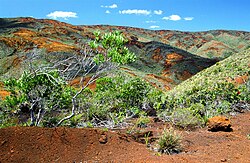
Soil cover over serpentinite bedrock tends to be thin or absent. Soil with serpentine is poor in calcium and other major plant nutrients, but rich in elements toxic to plants such as chromium and nickel.[46] Some species of plants, such as Clarkia franciscana and certain species of manzanita, are adapted to living on serpentinite outcrops. However, because serpentinite outcrops are few and isolated, their plant communities are ecological islands and these distinctive species are often highly endangered.[36] On the other hand, plant communities adapted to living on the serpentine outcrops of New Caledonia resist displacement by introduced species that are poorly adapted to this environment.[47]
In addition to New Caledonia and the Presidio of San Francisco,[36] serpentinite ecosystems are found in the State Line Serpentine Barrens of Pennsylvania and Maryland.[48]
Uses[]
Decorative stone in architecture and art[]
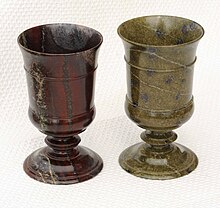
Serpentine group minerals have a Mohs hardness of 2.5 to 3.5, so serpentinite is easily carved.[49] Grades of serpentinite higher in calcite, along with the verd antique (breccia form of serpentinite), have historically been used as decorative stones for their marble-like qualities. College Hall at the University of Pennsylvania, for example, is constructed out of serpentine. Popular sources in Europe before contact with the Americas were the mountainous Piedmont region of Italy and Larissa, Greece.[50] Serpentinites are used in many ways in the arts and crafts. For example, the rock has been turned in Zöblitz in Saxony for several hundred years.[51]
Carving stone tools, oil lamp-known as the Qulliq and Inuit sculpture[]
The Inuit and other indigenous people of the Arctic areas and less so of southern areas used the carved bowl shaped serpentinite qulliq or kudlik lamp with wick, to burn oil or fat to heat, make light and cook with. The Inuit made tools and more recently carvings of animals for commerce.[52]
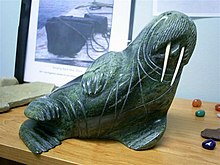
Magnetic serpentine walrus

Inuit Elder tending the Qulliq, a ceremonial oil lamp made of serpentinite.
Swiss ovenstone[]
A variety of chlorite talc schist associated with Alpine serpentinite is found in Val d'Anniviers, Switzerland and was used for making "ovenstones" (German: Ofenstein), a carved stone base beneath a cast iron stove.[53]
Neutron shield in nuclear reactors[]
Serpentinite has a significant amount of bound water, hence it contains abundant hydrogen atoms able to slow down neutrons by elastic collision (neutron thermalization process). Because of this serpentinite can be used as dry filler inside steel jackets in some designs of nuclear reactors. For example, in RBMK series, as at Chernobyl, it was used for top radiation shielding to protect operators from escaping neutrons.[54] Serpentine can also be added as aggregate to special concrete used in nuclear reactor shielding to increase the concrete density (2.6 g/cm3 (0.094 lb/cu in)) and its neutron capture cross section.[55][56]
CO2 sequestration[]
Because it readily absorbs carbon dioxide, serpentinite may be of use for sequestering atmospheric carbon dioxide.[57] To speed the reaction, the serpentinite may be reacted with carbon dioxide at elevated temperature in carbonation reactors. Carbon dioxide may also be reacted with alkaline mine waste from serpentine deposits, or carbon dioxide may be injected directly into underground serpentinite formations.[58] Serpentinite may also be used as a source of magnesium in conjunction with electrolytic cells for CO2 scrubbing.[59]
Cultural references[]
It is the state rock of California, USA and the California Legislature specified that serpentine was "the official State Rock and lithologic emblem."[60] In 2010, a bill was introduced which would have removed serpentine's special status as state rock due to it potentially containing chrysotile asbestos.[61] The bill met with resistance from some California geologists, who noted that the chrysotile present is not hazardous unless it is mobilized in the air as dust.[62]
See also[]
- Nephrite – Variety of jade
- Soapstone – Talc-bearing metamorphic rock
- Hydrogen cycle – Hydrogen exchange between the living and non-living world
References[]
- ^ Schoenherr, Allan A. (11 July 2017). A Natural History of California: Second Edition. Univ of California Press. pp. 35–. ISBN 9780520295117. Retrieved 6 May 2017.
- ^ "Serpentine definition". Dictionary of Geology. Retrieved 23 October 2018.
- ^ Jump up to: a b Moody, Judith B. (April 1976). "Serpentinization: a review". Lithos. 9 (2): 125–138. Bibcode:1976Litho...9..125M. doi:10.1016/0024-4937(76)90030-X.
- ^ Jump up to: a b Moody 1976, p. 129.
- ^ Jump up to: a b Berndt, Michael E.; Allen, Douglas E.; Seyfried, William E. (1 April 1996). "Reduction of CO2 during serpentinization of olivine at 300 °C and 500 bar". Geology. 24 (4): 351–354. Bibcode:1996Geo....24..351B. doi:10.1130/0091-7613(1996)024<0351:ROCDSO>2.3.CO;2.
- ^ Moody 1976, p. 128-129.
- ^ Jump up to: a b c d Serpentinization: The heat engine at Lost City and sponge of the oceanic crust
- ^ Jump up to: a b c d e Mével, Catherine (September 2003). "Serpentinization of abyssal peridotites at mid-ocean ridges". Comptes Rendus Geoscience. 335 (10–11): 825–852. Bibcode:2003CRGeo.335..825M. doi:10.1016/j.crte.2003.08.006.
- ^ Jump up to: a b c Lowell, R. P. (2002). "Seafloor hydrothermal systems driven by the serpentinization of peridotite". Geophysical Research Letters. 29 (11): 1531. Bibcode:2002GeoRL..29.1531L. doi:10.1029/2001GL014411.
- ^ Jump up to: a b c d Früh-Green, Gretchen L.; Connolly, James A.D.; Plas, Alessio; Kelley, Deborah S.; Grobéty, Bernard (2004). "Serpentinization of oceanic peridotites: Implications for geochemical cycles and biological activity". Geophysical Monograph Series. 144: 119–136. Bibcode:2004GMS...144..119F. doi:10.1029/144GM08. ISBN 0-87590-409-2.
- ^ Snow, Jonathan E.; Dick, Henry J.B. (October 1995). "Pervasive magnesium loss by marine weathering of peridotite". Geochimica et Cosmochimica Acta. 59 (20): 4219–4235. Bibcode:1995GeCoA..59.4219S. doi:10.1016/0016-7037(95)00239-V.
- ^ Jump up to: a b c Frost, B. R.; Beard, J. S. (3 April 2007). "On Silica Activity and Serpentinization". Journal of Petrology. 48 (7): 1351–1368. doi:10.1093/petrology/egm021.
- ^ Coleman, Robert G. (1977). Ophiolites. Springer-Verlag. pp. 100–101. ISBN 978-3540082767.
- ^ Jump up to: a b Moody 1976, p. 127.
- ^ Frost & Beard 2007, p. 1355.
- ^ Jump up to: a b Moody 1976, p. 125, 127, 131.
- ^ Frost & Beard 2007, pp. 1360–1362.
- ^ "Methane and hydrogen formation from rocks – Energy sources for life". Retrieved 6 November 2011.
- ^ Sleep, N.H.; A. Meibom, Th. Fridriksson, R.G. Coleman, D.K. Bird (2004). "H2-rich fluids from serpentinization: Geochemical and biotic implications". Proceedings of the National Academy of Sciences of the United States of America. 101 (35): 12818–12823. Bibcode:2004PNAS..10112818S. doi:10.1073/pnas.0405289101. PMC 516479. PMID 15326313.CS1 maint: multiple names: authors list (link)
- ^ Bach, Wolfgang; Paulick, Holger; Garrido, Carlos J.; Ildefonse, Benoit; Meurer, William P.; Humphris, Susan E. (2006). "Unraveling the sequence of serpentinization reactions: petrography, mineral chemistry, and petrophysics of serpentinites from MAR 15°N (ODP Leg 209, Site 1274)". Geophysical Research Letters. 33 (13): L13306. Bibcode:2006GeoRL..3313306B. doi:10.1029/2006GL025681. hdl:1912/3324.
- ^ Jump up to: a b Russell, M. J.; Hall, A. J.; Martin, W. (2010). "Serpentinization as a source of energy at the origin of life". Geobiology. 8 (5): 355–371. doi:10.1111/j.1472-4669.2010.00249.x. PMID 20572872.
- ^ Schrenk, M. O.; Brazelton, W. J.; Lang, S. Q. (2013). "Serpentinization, Carbon, and Deep Life". Reviews in Mineralogy and Geochemistry. 75 (1): 575–606. Bibcode:2013RvMG...75..575S. doi:10.2138/rmg.2013.75.18.
- ^ McCollom, Thomas M.; Bach, Wolfgang (February 2009). "Thermodynamic constraints on hydrogen generation during serpentinization of ultramafic rocks". Geochimica et Cosmochimica Acta. 73 (3): 856–875. Bibcode:2009GeCoA..73..856M. doi:10.1016/j.gca.2008.10.032.
- ^ Klein, Frieder; Bach, Wolfgang; McCollom, Thomas M. (September 2013). "Compositional controls on hydrogen generation during serpentinization of ultramafic rocks". Lithos. 178: 55–69. Bibcode:2013Litho.178...55K. doi:10.1016/j.lithos.2013.03.008.
- ^ Moody 1967, p. 128.
- ^ Delacour, Adélie; Früh-Green, Gretchen L.; Bernasconi, Stefano M. (October 2008). "Sulfur mineralogy and geochemistry of serpentinites and gabbros of the Atlantis Massif (IODP Site U1309)". Geochimica et Cosmochimica Acta. 72 (20): 5111–5127. Bibcode:2008GeCoA..72.5111D. doi:10.1016/j.gca.2008.07.018.
- ^ Moody 1976, p. 133.
- ^ Moody 1976, p. 128.
- ^ Baucom, Martin (March–April 2006). "Life on Mars?". American Scientist. 94 (2): 119–120. doi:10.1511/2006.58.119. JSTOR 27858733.
- ^ esa. "The methane mystery". European Space Agency. Retrieved 22 April 2019.
- ^ Jump up to: a b R. Glein, Christopher; Baross, John A.; Waite, Hunter (16 April 2015). "The pH of Enceladus' ocean". Geochimica et Cosmochimica Acta. 162: 202–219. arXiv:1502.01946. Bibcode:2015GeCoA.162..202G. doi:10.1016/j.gca.2015.04.017. S2CID 119262254.
- ^ Wall, Mike (7 May 2015). "Ocean on Saturn Moon Enceladus May Have Potential Energy Source to Support Life". Space.com. Retrieved 8 May 2015.
- ^ Moody 1976, p. 136.
- ^ Philpotts, Anthony R.; Ague, Jay J. (2009). Principles of igneous and metamorphic petrology (2nd ed.). Cambridge, UK: Cambridge University Press. pp. 370–372. ISBN 9780521880060.
- ^ Jump up to: a b c Hyndman, Roy D; Peacock, Simon M (July 2003). "Serpentinization of the forearc mantle". Earth and Planetary Science Letters. 212 (3–4): 417–432. Bibcode:2003E&PSL.212..417H. doi:10.1016/S0012-821X(03)00263-2.
- ^ Jump up to: a b c "Serpentinite". Presidio of San Francisco. National Park Service. Retrieved 3 September 2021.
- ^ Bostock, M. G.; Hyndman, R. D.; Rondenay, S.; Peacock, S. M. (May 2002). "An inverted continental Moho and serpentinization of the forearc mantle". Nature. 417 (6888): 536–538. Bibcode:2002Natur.417..536B. doi:10.1038/417536a. PMID 12037564. S2CID 3113794.
- ^ Minshull, T. A.; Muller, M. R.; Robinson, C. J.; White, R. S.; Bickle, M. J. (1998). "Is the oceanic Moho a serpentinization front?". Geological Society, London, Special Publications. 148 (1): 71–80. Bibcode:1998GSLSP.148...71M. doi:10.1144/GSL.SP.1998.148.01.05. S2CID 128410328.
- ^ Debret, B.; Nicollet, C.; Andreani, M.; Schwartz, S.; Godard, M. (February 2013). "Three steps of serpentinization in an eclogitized oceanic serpentinization front (Lanzo Massif - Western Alps): ECLOGITIZED SERPENTINIZATION FRONT (LANZO)". Journal of Metamorphic Geology. 31 (2): 165–186. doi:10.1111/jmg.12008.
- ^ Sinkankas, John (1964). Mineralogy for amateurs. Princeton, N.J.: Van Nostrand. pp. 149–480. ISBN 0442276249.
- ^ Philpotts & Ague 2009, p. 371.
- ^ Allen, Douglas E.; Seyfried, W.E. (March 2004). "Serpentinization and heat generation: constraints from Lost City and Rainbow hydrothermal systems 1 1Associate editor: J. C. Alt". Geochimica et Cosmochimica Acta. 68 (6): 1347–1354. doi:10.1016/j.gca.2003.09.003.
- ^ Jump up to: a b Fryer, Patricia (15 January 2012). [10.1146/annurev-marine-120710-100922 "Serpentinite Mud Volcanism: Observations, Processes, and Implications"] Check
|url=value (help). Annual Review of Marine Science. 4 (1): 345–373. Bibcode:2012ARMS....4..345F. doi:10.1146/annurev-marine-120710-100922. ISSN 1941-1405. PMID 22457979. - ^ Martin, William; Russell, Michael J (29 October 2007). "On the origin of biochemistry at an alkaline hydrothermal vent". Philosophical Transactions of the Royal Society B: Biological Sciences. 362 (1486): 1887–1926. doi:10.1098/rstb.2006.1881. PMC 2442388.
- ^ McCollom, T. M.; Seewald, J. S. (1 April 2013). "Serpentinites, Hydrogen, and Life". Elements. 9 (2): 129–134. doi:10.2113/gselements.9.2.129. Retrieved 5 September 2021.
- ^ "CVO Website - Serpentine and serpentinite" Archived 19 October 2011 at the Wayback Machine, USGS/NPS Geology in the Parks Website, September 2001, accessed 27 February 2011.
- ^ "La flore de Nouvelle-Calédonie – Première partie". Futura-sciences.com. 18 August 2004. Retrieved 30 January 2013.
- ^ "State Line Serpentine Barrens". Conservation Science; Protecting Pennsylvania's Plants and Animals. Western Pennsylvania Conservancy. Retrieved 3 September 2021.
- ^ Nesse, William D. (2000). Introduction to mineralogy. New York: Oxford University Press. p. 239. ISBN 9780195106916.
- ^ Ashurst, John. Dimes, Francis G. Conservation of building and decorative stone. Elsevier Butterworth-Heinemann, 1990, p. 51.
- ^ Eva Maria Hoyer: Sächsischer Serpentin: ein Stein und seine Verwendung. Edition Leipzig, Leipzig 1996, pp. 20–22.
- ^ Kerr, A.; Squires, G.C. "Serpentinites and associated rock types near Hopedale, Nunatsiavut: Potential for artisanal carving-stone resources" (PDF). Geological Survey Report. Newfoundland and Labrador Department of Natural Resources. 19 (1): 39–57. Retrieved 3 September 2021.
- ^ Talcose-schist from Canton Valais. By Thomags Bonney, (Geol. Mag., 1897, N.S., [iv], 4, 110--116) abstract
- ^ Lithuanian Energy Institute (28 May 2011). "Design of structures, components, equipments and systems". Ignalina Source Book. Retrieved 28 May 2011.
- ^ Aminian, A.; Nematollahi, M.R.; Haddad, K.; Mehdizadeh, S. (3–8 June 2007). Determination of shielding parameters for different types of concretes by Monte Carlo methods (PDF). ICENES 2007: International Conference on Emerging Nuclear Energy Systems. Session 12B: Radiation effects. Istanbul, Turkey. p. 7.
- ^ Abulfaraj, Waleed H.; Salah M. Kamal (1994). "Evaluation of ilmenite serpentine concrete and ordinary concrete as nuclear reactor shielding". Radiation Physics and Chemistry. 44 (1–2): 139–148. Bibcode:1994RaPC...44..139A. doi:10.1016/0969-806X(94)90120-1. ISSN 0969-806X.
- ^ Farhang, F.; Oliver, T.K.; Rayson, M.S.; Brent, G.F.; Molloy, T.S.; Stockenhuber, M.; Kennedy, E.M. (March 2019). "Dissolution of heat activated serpentine for CO2 sequestration: The effect of silica precipitation at different temperature and pH values". Journal of CO2 Utilization. 30: 123–129. doi:10.1016/j.jcou.2019.01.009.
- ^ Power, I. M.; Wilson, S. A.; Dipple, G. M. (1 April 2013). "Serpentinite Carbonation for CO2 Sequestration". Elements. 9 (2): 115–121. doi:10.2113/gselements.9.2.115.
- ^ Li, Wenzhi; Li, Wen; Li, Baoqing; Bai, Zongqing (February 2009). "Electrolysis and heat pretreatment methods to promote CO2 sequestration by mineral carbonation". Chemical Engineering Research and Design. 87 (2): 210–215. doi:10.1016/j.cherd.2008.08.001.
- ^ California Government Code § 425.2; see "Archived copy". Archived from the original on 28 June 2009. Retrieved 24 December 2009.CS1 maint: archived copy as title (link)
- ^ Fimrite, Peter (16 July 2010). "Geologists protest bill to remove state rock". SFGate. Retrieved 17 April 2018.
- ^ Frazell, Julie; Elkins, Rachel; O'Geen, Anthony; Reynolds, Robert; Meyers, James. "Facts about Serpentine Rock and Soil Containing Asbestos in California" (PDF). ANR Catalog. University of California Division of Agriculture and Natural Resources. Retrieved 17 April 2018.
External links[]
| Wikimedia Commons has media related to Serpentinite. |
- [1] The Lost City hydrothermal field, Mid-Atlantic ridge: serpentinization, the driving force of the system.
- H2-rich fluids from serpentinization: Geochemical and biotic implications: Proceedings of the National Academy of Sciences.
- Serpentine group
- Metamorphic petrology
- Metamorphic rocks

